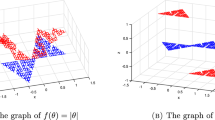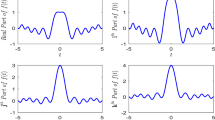Abstract
The filterbank transceiver structure for fractal modulation has been developed. It has been shown that the transceiver complexity is comparable to that of OFDM.The use of orthogonal space time block codes (OSTBC) in conjunction with Fractal Modulation (STFrM) in the presence of frequency selective fading channels has also been considered. An L scale fractal modulation and coherent demodulation effectively converts a frequency selective channel into L flat fading channels per information symbol with random scale gains. The analysis of the proposed scheme in terms of bit error rate has been performed. A diversity order of m T m R L can be achieved, where m T ,m R are the number of transmitters and receivers, respectively. This increase in diversity order in comparison with that achieved for the OFDM case is at a cost of lower spectral efficiency. However the spectral efficiency of STFrM can be improved R times by the use of multiplicity ‘R’ multiwavelets.
Similar content being viewed by others
References
Larsson, E. G. (2003). PetreStoica, Space–time block coding for wireless communications. Cambridge University Press
Paulraj, A., Nabar, R., Gore, D. (2003). Introduction to space–time wireless communications. Cambridge University Press.
Erdol N., Bao F., Chen Z. (1995) Wavelet modulation: A prototype for digital communication systems. IEEE Southcon Conference 7: 168–170
Wornell G. W., Oppenheim A. V. (1992) Wavelet based representation for a class of self similar signals with application to fractal modulation. IEEE Transaction on Information Theory 38(2): 785–800
Jones, W. W. (1994). Multi-scale wavelet modulation. In Proceedings of the 2nd southern symposium on system theory, pp. 576–580 (March).
Manglani M. J., Bell A. E. (2001) Wavelet modulation performance in Gaussian and Rayleigh fading channels. IEEE MILCOM 44(12): 1629–1631
Livingston J. N., Tung C. (1996) Bandwidth efficient PAM signalling using wavelets. IEEE Transaction on Communication 44(12): 1629–1631
Mittal, V., Gautam, Y., Mallik, R. K., & Joshi, S.D. (2004). Analysis of wavelet modulation in frequency-selective fading. IEEE Globecom, pp. 452–456 (June).
Xia X. G. (1997) New precoding for intersymbol interference cancellation using nonmaximally decimated multirate filterbanks with ideal FIR equalisers. IEEE Transaction on Signal Processing 40: 2431–2441
Akansu A. N. (1998) Orthogonal transmultiplexers in communication: A review. IEEE Transaction on Signal Processing 46: 979–995
Giannakis G. B., Barbarossa S. (1999a) Redundant filterbank precoders and equalizers part I: Unification and optimal designs. IEEE Transaction on Signal Processing 47: 1988–2006
Giannakis G. B., Barbarossa S. (1999b) Redundant filterbank precoders and equalizers part II: Blind channel estimation, synchronization, and direct equalization. IEEE Transaction on Signal Processing 47: 2007–2022
Sampath H., Stoica P., Paulraj A. (2001) Generalized linear precoder and decoder design for MIMO Channels using the weighted MMSE criterion. IEEE Transaction on Communications 49: 2198–2206
Scaglione A., Stoica P., Barbarossa S., Giannakis G. B., Sampath H. (2002) Optimal designs for space-time linear precoders and decoders. IEEE Transaction on Signal processing 50: 1051–1063
Lin Y. P., Phoong S. M. (2002) Minimum redundancy for ISI free FIR filterbank transceivers. IEEE Transaction on Signal Processing 50: 842–853
Inouye Y., Liu R. W. (2002) A system-theoretic foundation for blind equalization of an FIR MIMO channel system. IEEE Transaction on Circuits and systems-I 49: 425–436
Atzori L., Giusto D. D., Murroni M. (2002) Performance analysis of fractal modulation transmission over fast fading wireless channels. IEEE Transaction on Broadcasting 48(6): 103–110
Sklar B. (1997) Rayleigh fading channels in mobile digital communication systems part-I: Characterzation. IEEE Communication Magazine 35: 90–100
Burrus C. S., Gopinath R. A., Guo H. (2003) Introduction to wavelets and wavelet transforms. Prentice Hall, Englewood Cliffs
Vaidyanathan P. P., Mitra S. K. (1988) Polyphase networks, block digital filtering, LPTV systems, and Alias-Free QMF banks: A unified approach based on pseudocirculants. IEEE Transaction on Acoustics, Speech, and Signal Processing 36: 381–391
Alamouti S. M. (1998) A simple transmit diversity technique for wireless communication. IEEE Journal on Selected Area in Communication 16: 1451–1458
Seshadri N., Calderbank A. (1998) Space time codes for high data rate wireless communication: Performance criterion and code construction. IEEE Transaction on Information Theory 44: 744–765
Proakis J. G. (1995) Digital communications (3rd ed.). McGraw-Hill, New York
Jiang Q. (1998) Orthogonal multiwavelets with optimum time-frequency resolution. IEEE Transaction on Signal Processing 46: 830–844
Author information
Authors and Affiliations
Corresponding author
Rights and permissions
About this article
Cite this article
Sengar, S., Joshi, S.D. & Prasad, S. Transceiver Design and Performance Analysis of Space Time Coded Fractal Modulation. Wireless Pers Commun 60, 345–362 (2011). https://doi.org/10.1007/s11277-010-9959-x
Published:
Issue Date:
DOI: https://doi.org/10.1007/s11277-010-9959-x




